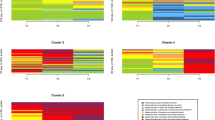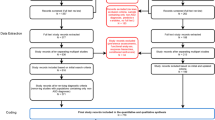Abstract
Six psychiatry inpatients were observed during mealtimes to determine and evaluate staff intervention techniques. To extend and further elaborate the findings of a previous work (Pines, Kupst, Natta, & Schulman, 1985), staff behaviors (positive, punitive, isolating, and neutral) were investigated for their potential relationship to subsequent child behaviors (positive, negative, and inactive) via a lag sequential analytic approach. Staff punitive and isolating behaviors tended to be associated with significant increases in the likelihood of subsequent child negative behaviors and with significant decreases in child positive behaviors. Staff positive behaviors tended not to be related to a subsequent increase or decrease in any of the coded child behaviors. Findings demonstrate the utility of assessing conditional probabilities of sequences of staff-child behaviors in psychiatric inpatients.
Similar content being viewed by others
References
Allison, P. D., & Liker, J. K. (1982). Analyzing sequential categorical data on dyadic interaction: A comment on Gottman.Psychological Bulletin, 91, 393–403.
American Psychiatric Association. (1980).Diagnostic and statistical manual of mental disorders (DSM-III). Washington, DC: Author.
Bakeman, R. (1978). Untangling streams of behavior: Sequential analysis of observation data. In G. P. Sackett (Ed.),Observing behavior: Vol. II. Data collection and analysis methods (pp. 63–78). Baltimore: University Park Press.
Bakeman, R., & Gottman, J. M. (1986).Observing interaction: An introduction to sequential analysis. New York: Cambridge.
Bettelheim, B., & Sylvester, R. (1948). A therapeutic milieu.American Journal of Orthopsychiatry, 18, 191–206.
Blotcky, M. J., Dimperio, T. L., & Gossett, T. J. (1984). Follow-up of children treated in psychiatric hospitals: A review of studies.American Journal of Psychiatry, 141, 1499–1507.
Cataldo, M., & Risley, T. R. (1974). Evaluation of living environments: The MANIFEST description of ward activities. In P. O. Davidson, F. W. Clark, & L. A. Hamerlynck (Eds.),Evaluation of behavioral programs in community, residential and school settings (pp. 201–227). Champaign, IL: Research Press.
Cohen, J. (1960). A coefficient of agreement for scales.Educational and Psychological Measurement, 20, 37–46.
Forehand, R. L., & McMahon, R. J. (1981).Helping the noncompliant child: A clinicians guide to parent training. New York: Guilford Press.
Garfield, S. L., & Bergin, A. E. (1978).Handbook of psychotherapy and behavior change. New York: Wiley.
Goodrich, D. W., & Dittman, A. T. (1960). Observing interactional behavior in residential treatment.Archives of General Psychiatry, 2, 421–428.
Gottman, J. M. (1979).Marital interaction: Experimental investigations. New York: Academic Press.
Gottman, J. M. (1980). Analysis for sequential connection and assessing for interobserver reliability for the sequential analysis of observational data.Behavioral Assessment, 2, 361–368.
Hersen, M., & Barlow, D. H. (1976).Single-case experimental designs: Strategies for studying behavior change. New York: Pergamon Press.
Holmbeck, G. N., & Kendall, P. C. (in press). Clinical-childhood-developmental interface: Implications for treatment. In P. R. Martin (Ed.),Handbook of behavior therapy and psychological science: An integrative approach. Elmsford, NY: Pergamon Press.
Irwin, M. (1982). Literature review. In J. L. Schulman & M. Irwin (Eds.),Psychiatric hospitalization of children (pp. 5–42). Springfield, IL: Charles C Thomas.
Islam, A., & Turner, D. L. (1982). The therapeutic community: A critical reappraisal.Hospital and Community Psychiatry, 33, 651–653.
Kendall, P. C. (1984). Social cognition and problem solving: A developmental and child-clinical interface. In B. Gholson & T. L. Rosenthal (Eds.),Applications of cognitive-developmental theory (pp. 115–148). New York: Academic Press.
Kerlinger, F. N. (1964).Foundations of behavioral research. New York: Holt, Rinehart & Winston.
Lovaas, O. I., Freitag, G., Gold, V. J., & Kassorla, I. C. (1965). Recording apparatus and procedure for observation of children in free-play setting.Journal of Experimental Child Psychology, 2, 108–120.
Monkman, M. (1972).A milieu therapy program for behaviorally disturbed children. Springfield, IL: Charles C Thomas.
Patterson, G. R. (1977). Accelerating stimuli for two classes of coercive behaviors.Journal of Abnormal Child Psychology, 5, 335–350.
Patterson, G. R. (1982).Coercive family processes. Eugene, OR: Castalia.
Patterson, G. R., & Forgatch, M.S. (1985). Therapist behavior as a determinant for client noncompliance: A paradox for the behavior modifier.Journal of Consulting and Clinical Psychology, 53, 846–851.
Paul, G. L. (Ed.). (1987).Observational assessment instrumentation for service and research: Assessment in residential treatment settings (Parts 2–5). Champaign, IL: Research Press.
Petti, T. A. (1980). Residential and inpatient treatment. In G. P. Sholevar, R. M. Benson, & B. J. Binder (Eds.),Emotional disorders in children and adolescents (pp. 209–228). Jamaica, NY: Spectrum Publications Medical and Scientific Books.
Pines, R. J., Kupst, M. J., Natta, M. B., & Schulman, J. L. (1985). Staff-patient ratio and type of interaction on a child psychiatry inpatient unit.Child Psychiatry and Human Development, 16, 14–29.
Polsky, H. W., & Claster, D. S. (1968).The dynamics of residential treatment: A social system analysis. Chapel Hill: University of North Carolina Press.
Redl, F. (1959). The concept of a therapeutic milieu.American Journal of Orthopsychiatry, 29, 721–736.
Reid, J. B. (Ed.). (1978).A social learning approach to family intervention. Vol. 2. Observation in home settings. Eugene, OR: Castalia.
Rimm, D. C., & Masters, J. C. (1979).Behavior therapy: Techniques and empirical findings. New York: Academic Press.
Sackett, G. P. (1979). The lag sequential analysis of contingency and cyclicity in behavioral action research. In J. D. Osofsky (Ed.),Handbook of infant development (pp. 623–649). New York: Wiley.
Schulman, J. L., & Irwin, M. (Eds.). (1982).Psychiatric hospitalization of children. Springfield, IL: Charles C Thomas.
Stone, L. A. (1979). Residential treatment. In J. D. Noshpitz (Ed.),Basic handbook of child psychiatry (Vol. 3, pp. 231–262). New York: Basic Books.
Vuchinich, S. (1984). Sequencing and social structure in family conflict.Social Psychology Quarterly, 47, 217–234.
Werry, J. S. (1979). The childhood psychosis. In H. C. Quay & J. S. Werry (Eds.),Psychopathological disorders of childhood (2nd ed., pp. 43–89). New York: Wiley.
Author information
Authors and Affiliations
Additional information
Thanks are due to Margery Johnson, M.D., and the staff of the Child Psychiatry Inpatient Unit, and especially to the IPU research team: Karen Geary, Patricia Kennedy, John Lutz, Joyce Weishaar, Gary Westman, and Caryl Zaar. We are also grateful to Bernardine Van Dygriff for help in preparing the manuscript, and to the Margaret Etter Creche Learning Center for their support of this project.
Rights and permissions
About this article
Cite this article
Natta, M.B., Holmbeck, G.N., Kupst, M.J. et al. Sequences of staff-child interactions on a psychiatric inpatient unit. J Abnorm Child Psychol 18, 1–14 (1990). https://doi.org/10.1007/BF00919452
Revised:
Issue Date:
DOI: https://doi.org/10.1007/BF00919452




